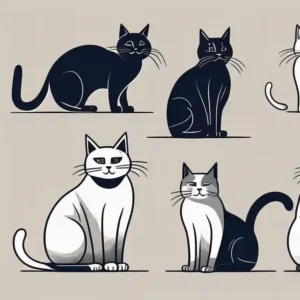
Curious about Why Do Cats Wag Their Tails
Cats are known for their mysterious and sometimes unpredictable behavior. One of the most fascinating and well-known cat behaviors is tail wagging. We often associate tail wagging with dogs, but cats wag their tails too, and they have their own reasons for doing so. In this article, we will explore the various motives behind cat tail wagging and uncover the secrets of this intriguing feline behavior. Understanding Cat Body Language Cat body language is a complex system of communication that includes various movements, postures, and vocalizations. By deciphering these signals, we can better understand our feline friends and respond appropriately to their needs. The tail is a significant part of a cat’s communication toolkit, and its movements can convey a wide range of messages. The Role of the Tail in Feline Communication The tail serves as an extension of a cat’s emotions and intentions. It plays a crucial role in feline communication, helping them express their feelings and communicate with other cats and even humans. Understanding the different tail movements is key to interpreting a cat’s mood and needs. Moreover, the position of a cat’s tail can also provide valuable insights into their state of mind. A tail held upright in a confident manner indicates a happy and self-assured cat, while a tail tucked between the legs suggests fear or submission. Observing the tail in conjunction with other body language cues can paint a more complete picture of a cat’s emotional state. Decoding Different Tail Movements Cats use various tail movements to convey their emotions. A slow, gentle swaying motion often signifies relaxation and contentment. On the other hand, rapid side-to-side movements can indicate agitation or annoyance. It’s important to observe the overall context and other body language cues to accurately interpret what a cat is trying to communicate. Additionally, a puffed-up tail can signal that a cat is feeling threatened or scared, as they try to appear larger to intimidate potential threats. Conversely, a tail wrapped around another cat or human is a sign of affection and bonding. Understanding these nuances in tail movements can deepen your bond with your feline companion and improve your communication with them. The Science Behind Tail Wagging Behind every cat behavior, there is a scientific explanation. Tail wagging is no exception. It involves a complex interplay between a cat’s nervous system, emotions, and overall well-being. Understanding the intricacies of a cat’s tail wagging can provide valuable insights into their state of mind and emotional well-being. Observing the nuances of this behavior can help cat owners better understand and communicate with their feline companions. The Nervous System and Tail Movements The tail is an extension of a cat’s spine, consisting of several vertebrae. The nerves in this area play a crucial role in coordinating tail movements. A cat’s nervous system sends signals to different muscles in the tail, resulting in various wagging patterns. Additionally, the tail serves as a vital tool for cats to maintain balance and communicate with other animals. The subtle movements and positions of the tail can convey important information about a cat’s intentions and mood, making it a key aspect of feline body language. The Connection Between Emotions and Tail Wagging Cats are incredibly emotional creatures, and their tails often express these emotions. A cat wagging its tail rapidly could be experiencing fear, insecurity, or even anger. Conversely, a slow and relaxed wag can indicate a calm and content feline. It’s essential for cat owners to pay attention to the context in which tail wagging occurs. Factors such as the cat’s body posture, ear position, and vocalizations can provide valuable context to interpret the meaning behind the tail movements. By considering these cues holistically, cat owners can deepen their bond with their pets and ensure their well-being. Common Reasons for Tail Wagging Now that we understand the basics of cat tail wagging, let’s explore some of the most common reasons behind this behavior. Expressing Happiness or Contentment Contrary to popular belief, not all tail wagging in cats is a sign of distress or agitation. When a cat wags its tail gently and slowly, it is often a display of happiness and contentment. It’s their way of saying, “Life is good!” Signaling Fear or Agitation On the flip side, an agitated or fearful cat may wag its tail more vigorously or rapidly. This is a clear sign that the cat is uncomfortable or threatened in its current environment. It’s crucial to respect their boundaries and give them space when they display this behavior. Indicating Illness or Discomfort In some cases, tail wagging can be a symptom of an underlying health issue or discomfort. Cats may try to alleviate their discomfort by repeatedly flicking or twitching their tails. If you notice excessive or unusual tail wagging accompanied by other unusual behaviors or physical symptoms, it’s important to consult a veterinarian. Moreover, tail wagging can also serve as a form of communication between cats. When two cats interact, they may use their tails to convey messages to each other. A slow, gentle wag may indicate that one cat is feeling friendly and approachable, while a rapid, aggressive wag could signal a warning to stay away. Expressing Curiosity or Playfulness Another reason for tail wagging in cats is curiosity or playfulness. When a cat is exploring a new environment or engaging in a playful activity, you may notice their tail twitching or wagging in excitement. This behavior is often accompanied by other playful gestures such as pouncing, chasing, or batting at objects. Misconceptions About Cat Tail Wagging There are many misconceptions surrounding cat tail wagging, and it’s essential to separate fact from fiction. One common misconception is that all tail wagging in cats is a sign of happiness or excitement, similar to dogs. However, cat tail movements are much more nuanced and can convey a range of emotions and intentions. It’s crucial for cat owners to understand these subtleties to better communicate with their feline companions. Comparing Cat and Dog Tail Movements Cat tail wagging differs significantly from that of dogs. While


